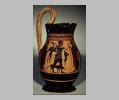[Image not available]
Three-dimensional approximation of the vase

Main panel: hunter between two men
| Collection: | London, British Museum |
| Summary: | Body: Hunter carrying game, standing between 2 men with staffs. |
| Ware: | Attic Black Figure |
| Painter: | Attributed to the Amasis Painter |
| Date: | ca. 550 BC - ca. 540 BC |
| Dimensions: | H. 0.254 m.; D. 0.134 m. |
| Primary Citation: | |
| Shape: | Olpe |
| Beazley Number: | 310458 |
| Period: | Archaic |
Date Description:
"This olpe stands somewhat apart from the others painted by the Amasis Ptr. and may well be the earliest."
Decoration Description:
Ext.: A hunter, carrying game and accompanied by his dog, stands between 2 men holding staffs. The hunter wears a fringed leather cap and a short belted chiton, also fringed. He carries the game (a fox and an hare) on a lagobolon, or yokelike stick, on his left shoulder. He walks to the right, his dog beside him on his left side. In front of the hunter stands a bearded man with short red hair, holding a staff in his right hand. His left arm is bent under his himation. Behind the hunter, another short haired man, wearing a himation, stands facing right. He holds a staff in his right hand. The clothing of all 3 men is decorated with red dots and dot-rosettes. The dot-rosettes have a red center and white petals.
The theme of this vase is the return of a successful hunter, as seen on a lip- cup inscribed by Tleson as potter, now in the British Museum,
The figural panel is on one side of the vase, beginning to the right of the handle and ending opposite the handle. It is bordered at the top by an ornamental strip of seventeen upright black buds with dots in the interstices. On the side to the left of the handle are two reserved spandrels with a black disk between them, which might represent an apotropaic eye.
Shape Description:
Trefoil mouth
Graffiti:
Several scratches at the top of the handle could be the remains of a graffito.
Sources Used:
Other Bibliography:
BABesch 41 (1966) 84-85, fig. 5